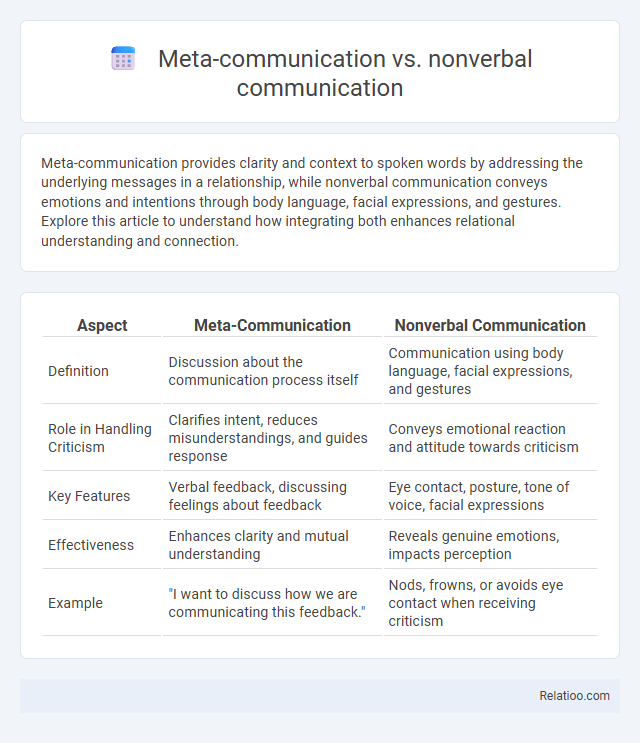Meta-communication provides clarity and context to spoken words by addressing the underlying messages in a relationship, while nonverbal communication conveys emotions and intentions through body language, facial expressions, and gestures. Explore this article to understand how integrating both enhances relational understanding and connection.
Table of Comparison
| Aspect | Meta-Communication | Nonverbal Communication |
|---|---|---|
| Definition | Discussion about the communication process itself | Communication using body language, facial expressions, and gestures |
| Role in Handling Criticism | Clarifies intent, reduces misunderstandings, and guides response | Conveys emotional reaction and attitude towards criticism |
| Key Features | Verbal feedback, discussing feelings about feedback | Eye contact, posture, tone of voice, facial expressions |
| Effectiveness | Enhances clarity and mutual understanding | Reveals genuine emotions, impacts perception |
| Example | "I want to discuss how we are communicating this feedback." | Nods, frowns, or avoids eye contact when receiving criticism |
Introduction to Meta-communication and Nonverbal Communication
Meta-communication refers to the underlying messages and context that shape how verbal communication is interpreted, influencing your understanding of tone, intention, and emotions. Nonverbal communication encompasses body language, facial expressions, gestures, and posture that convey meaning without words, often reinforcing or contradicting spoken messages. Together, meta-communication and nonverbal signals provide a comprehensive framework for interpreting interactions beyond surface-level speech.
Defining Meta-communication: Meaning and Scope
Meta-communication refers to the underlying messages or signals that accompany verbal communication, providing context and meaning beyond the spoken words. It encompasses tone of voice, gestures, facial expressions, and body language, which help interpret and modify the explicit content of communication. Nonverbal communication is a key component of meta-communication, as it conveys emotions and attitudes that influence how messages are understood within interpersonal interactions.
Understanding Nonverbal Communication: Types and Examples
Understanding nonverbal communication involves recognizing various types such as facial expressions, gestures, posture, eye contact, and proxemics, each conveying emotions and intentions beyond words. Meta-communication refers to the underlying messages about how to interpret the primary message, often conveyed through tone, body language, or context, clarifying the meaning behind verbal and nonverbal cues. By mastering these distinctions, you can enhance your ability to interpret and utilize communication effectively in personal and professional interactions.
Key Differences Between Meta-communication and Nonverbal Communication
Meta-communication involves the underlying messages conveyed through tone, context, and style that frame verbal interactions, while nonverbal communication includes body language, facial expressions, and gestures that express emotions without words. You use meta-communication to clarify or modify the meaning of spoken words, whereas nonverbal communication conveys feelings and attitudes independently of verbal content. Understanding these key differences enhances your ability to interpret and deliver messages effectively in social and professional settings.
The Role of Context in Meta-communication
Meta-communication relies heavily on the role of context to clarify the underlying meaning of a message, where your tone, facial expressions, and situational cues guide interpretation beyond the spoken words. Nonverbal communication encompasses gestures, posture, and eye contact as standalone signals that convey emotion or intent without spoken language. Understanding the context allows you to decode meta-communication accurately, ensuring messages are interpreted as intended within the specific social or cultural environment.
Significance of Nonverbal Signals in Everyday Interactions
Nonverbal communication plays a crucial role in everyday interactions by conveying emotions, intentions, and attitudes without words, often complementing or contradicting spoken messages. Meta-communication, as communication about communication, helps clarify the meaning behind nonverbal signals, enhancing mutual understanding and reducing misinterpretations. Recognizing and interpreting these nonverbal cues accurately improves interpersonal relationships and facilitates effective communication across cultural contexts.
How Meta-communication Influences Communication Outcomes
Meta-communication shapes communication outcomes by clarifying the context and intent behind verbal messages, reducing misunderstandings and enhancing mutual comprehension. Nonverbal communication conveys emotions and social cues through body language, facial expressions, and tone, supporting or contradicting the spoken word. Your ability to effectively use meta-communication can guide conversations toward more constructive and transparent interactions, improving overall communication effectiveness.
Challenges in Interpreting Nonverbal Cues
Interpreting nonverbal cues presents significant challenges due to cultural differences, individual variability, and contextual ambiguity, which often result in miscommunication despite shared physical signals. Meta-communication provides a framework for clarifying these ambiguities by explicitly addressing the meaning behind nonverbal behaviors, yet it requires mutual awareness and willingness to engage that may not always be present. Unlike meta-communication's conscious dialogue about communication itself, nonverbal signals operate unconsciously and are more prone to misinterpretation without additional verbal clarification.
Real-life Scenarios: Meta-communication vs Nonverbal Communication
Meta-communication involves the explicit use of language to discuss or clarify the meaning of the communication process itself, such as saying "I'm joking" to signal humor in a conversation. Nonverbal communication relies on body language, facial expressions, and gestures to convey meaning without words, like a smile indicating friendliness or crossed arms suggesting defensiveness. In real-life scenarios, meta-communication helps resolve misunderstandings by making implicit messages explicit, whereas nonverbal communication provides contextual cues that shape the interpretation of verbal exchanges.
Enhancing Communication Skills: Integrating Both Approaches
Enhancing communication skills involves integrating meta-communication and nonverbal communication to create clearer and more effective interactions. Meta-communication, which refers to the underlying messages about the communication itself, helps clarify intent and context, while nonverbal cues such as body language, facial expressions, and tone of voice provide essential emotional and relational information. Combining these approaches allows individuals to understand and convey messages more accurately, reducing misunderstandings and improving interpersonal connections.

Infographic: Meta-communication vs Nonverbal communication
 relatioo.com
relatioo.com